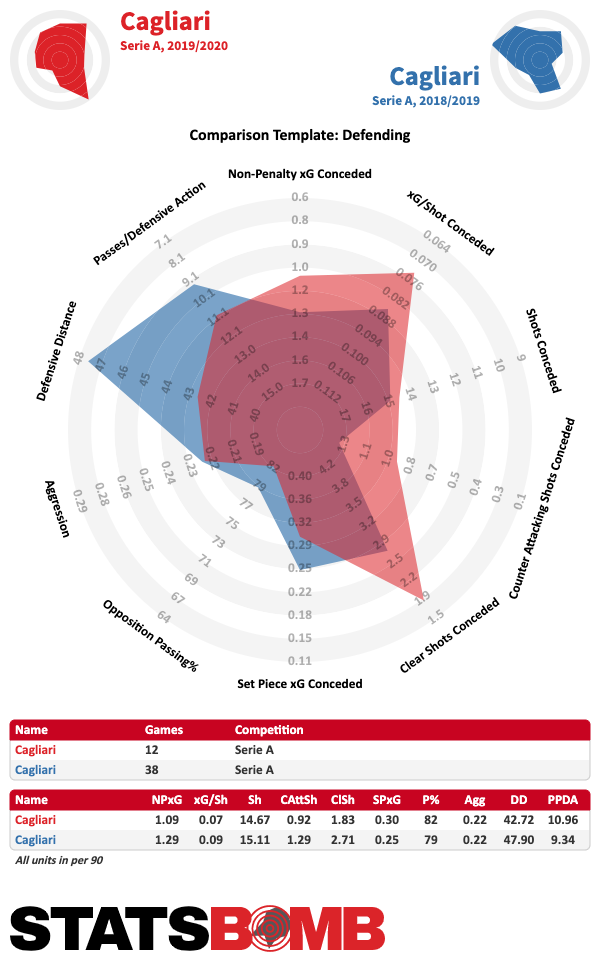Over the last decade, Cagliari have accustomed its fans to relegation battles. The side have never achieved a finish in the top half of the table and on one occasion were even relegated to Serie B.
To give you a clearer idea, these are, in chronological order, Cagliari’s final league placements in the last ten seasons. 16th, 14th, 15th, 11th, 15th, 18th (relegated), 1st (Serie B), 12th, 15th, 15th
This season the team, led by Rolando Maran, finally have the opportunity to reverse the trend and compete for something more. After 12 games, the Rossoblu have taken 24 points, more than half of those won in the whole of 2018–19 (41). If the season ended today, they'd qualify for the Champions League, sitting fourth in the table.
Cagliari had a bad start, losing their first two games against Brescia and Inter, the latter a game now infamous for the fans' racist abuse of Romelu Lukaku, for which they received no punishment for verbally abusing the Inter forward. They've used that match as a springboard and have defeated Napoli (1-0 at the Stadio San Paolo) and Atalanta (2-0 at the Gewiss Stadium), two teams now behind them in the standings. In the last game before the international break, they trashed Fiorentina 5-2.
So, it doesn't seem like a season like any other. And in a certain sense, it isn't a season like any other, because this year Cagliari celebrates their centenary. In 1920 a surgeon named Gaetano Fichera founded Cagliari Football Club, which played their first game with a white uniform that Fichera had made up by fitting hospital uniforms.
To celebrate the anniversary and to raise the average quality level of the team, Cagliari's summer transfer campaign was paradoxically built on the sale of their academy product and best player, Niccolò Barella, to Inter for a sum that, including bonuses, could reach €50 million. That's a huge amount (although largely not yet cashed) for a club that has generated a grand total of €73 million in revenue in 2018–19.
President Tommaso Giulini and the management of the club decided to renew Maran's contract until 2022, and to reinvest the Barella money on three midfielders who seemed unreachable: Uruguayan prospect Nahitan Nández (€18M) from Boca Juniors, skilled central midfielder Marko Rog (on loan from Napoli) and Radja Nainggolan, who turned heads at Cagliari five years ago, is back once again, on loan from Inter. Their bold transfers and the club's willingness to spend didn't stop there. Fans have particularly delighted in Christian Oliva (another Uruguayan), left-back Luca Pellegrini (on loan from Juventus), striker Alberto Cerri and especially Giovanni "Cholito" Simeone, on loan from Fiorentina (with that inescapable "option" to buy") to replace injured forward Leonardo Pavoletti, who scored 16 goals last season. Pavoletti, first in the league in aerial wins, had a huge influence on Cagliari’s style of play and substantially overperformed his expected goals thanks to his crazy aerial ability, which allowed him to score 11 headers in 2018–19. Look at all those circles in his shotmap.

In addition to their battering ram, Cagliari also lost Alessio Cragno to injury, the goalkeeper who in their last edition of Serie A saved the most goals, compared to the average keeper (9.93 goals saved above average). In his place came Robin Olsen, ill-treated goalkeeper of AS Roma, currently a key performer in the success of Maran's team. #Cagliari are indeed overperforming, having conceded just 9 non-penalty goals from 13.18 xG, a feat accomplished largely thanks to their Swedish keeper. Olsen has saved 85% of the shots he has faced, 14% more shots than the average keeper (the associated expected save percentage is just 71%). He also has the highest GSAA,, 6.68, in Serie A. In other words, he's preventing 0.56 goals more than the average keeper every game he plays, but he won’t necessarily keep this form for the entire season.
Yet Olsen’s performances should not underestimate Cagliari’s defense, which is actually worthy of the top five, with 1.09 xG conceded per game. Despite conceding 14.67 shots per game (13th in the league), Cagliari are quite good at preventing high-quality scoring chances. While they have the third-closest shot distance, their average xG per shot is the third-best in the league at 0.07. Moreover, they are sixth in clear shots conceded (1.83 per game)—opponent shots generated when only the goalkeeper is between the shot-taker and goal—and fourth in counterattacking shots conceded (0.92).
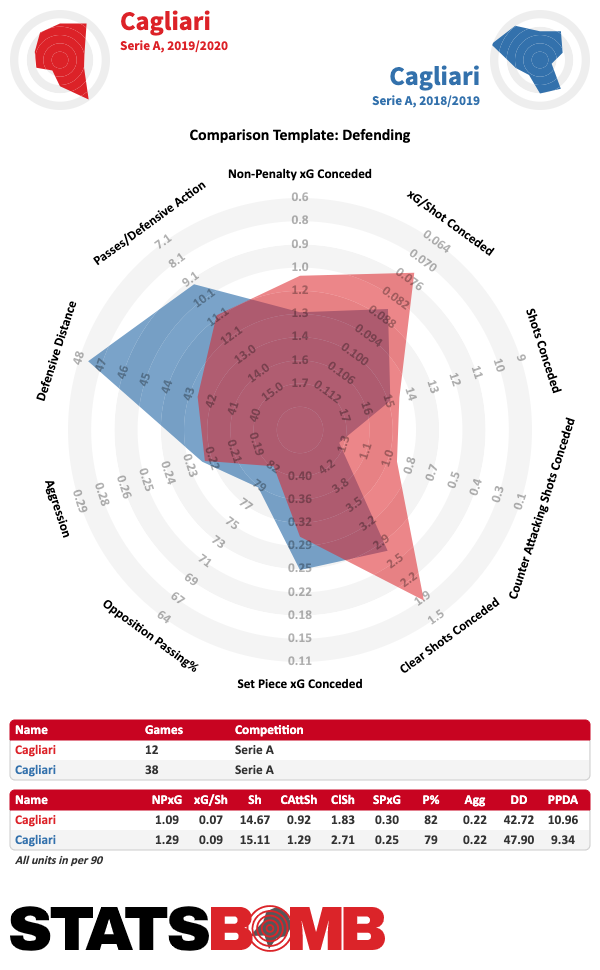
Maran abandoned the high-pressing defensive system he tried to implement last season, when Cagliari recorded the furthest defensive distance in the Serie A (47.90) but consistently failed to prevent central penetration, and started to defend way deeper, so much so that now they are the team that defends closest to its own goal (42.72), if we exclude Lecce (currently hovering a point above the relegation zone). They now allow opponents 55% possession (+5%) and a pass completion of 82% (+3%).
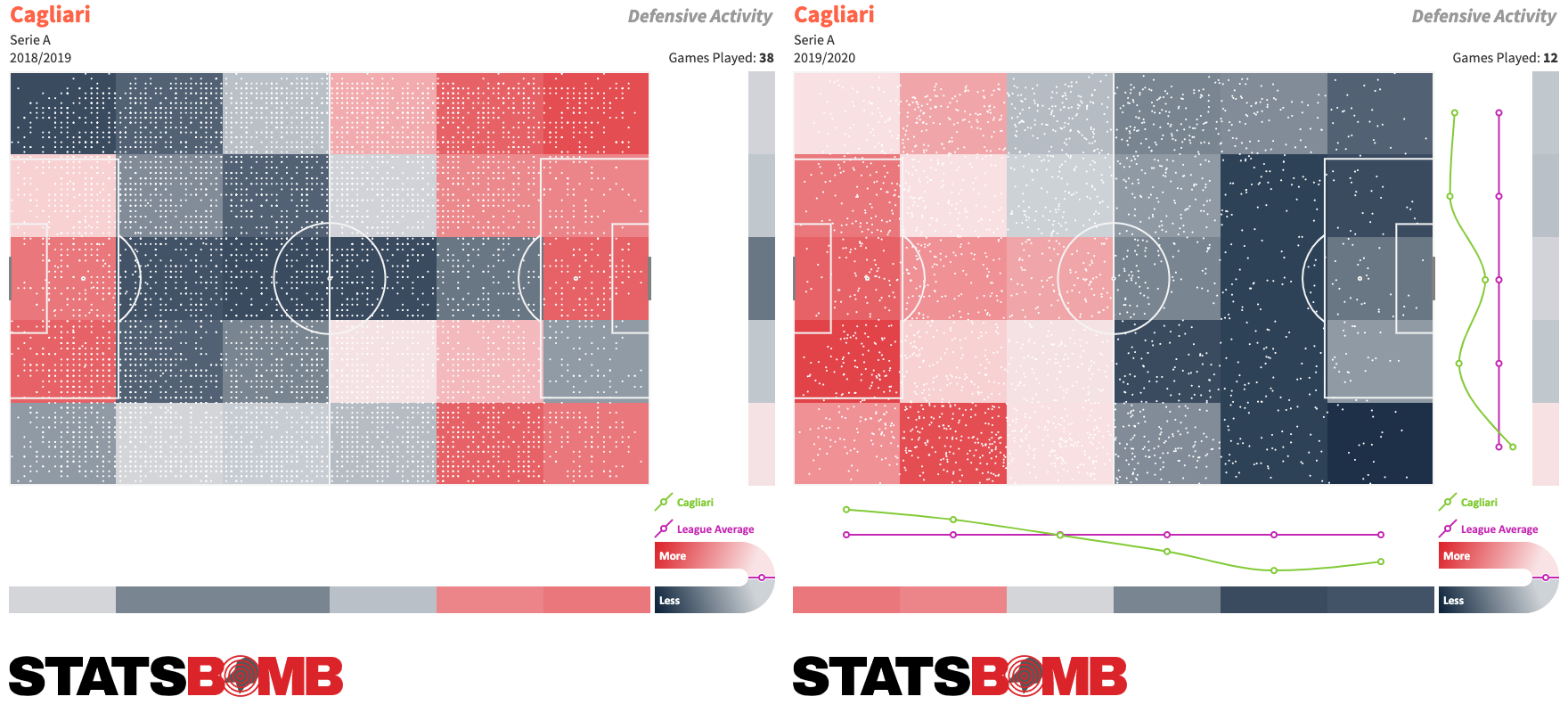
As you can see from the two comparative defensive actions map, Cagliari's passes allowed per defensive action increased dramatically this season (from 7th to 16th best in the league). But they improved their ability to defend the center of the pitch, and now concede 30% less non-penalty goals and 15.5% less non-penalty xG per game in comparison to last season, both thanks to better-suited midfielders and a tactical change.
Maran gradually switched from a 4-3-1-2 to a 4-3-2-1, a system that allows him to have five central midfielders to create defensive overloads in the center and force opponents to play wide while than giving his team a clear advantage on rebounds and contested balls. Nainggolan, currently one of the best creators in Serie A, is thriving in an offensive midfielder role next to João Pedro, and added two goals from just 0.56 xG.
This new setup is well suited to the offensive game of Cagliari, intended to function as a direct team with rapid transitions. Defending low allows them to have more space to attack behind the opposing team, while the numerical superiority in midfield permits them to take risks in their passing game, as they quite often have the chance to try to challenge for the ball immediately.
Their pace toward goal is the fourth fastest in the league at 2.82, and they are completing just 75% percent of their passes, both of which demonstrate their direct approach. They have more than doubled their average of counterattacking shots from 0.53 to 1.08, but apart from that, they haven’t improved much offensively.
Cagliari are still struggling to create chances (although they have improved from 0.94 to 1.06 xG per game) but they are currently riding on conversion, since their finishing granted them 22 open-play goals out of just 12.92 xG.
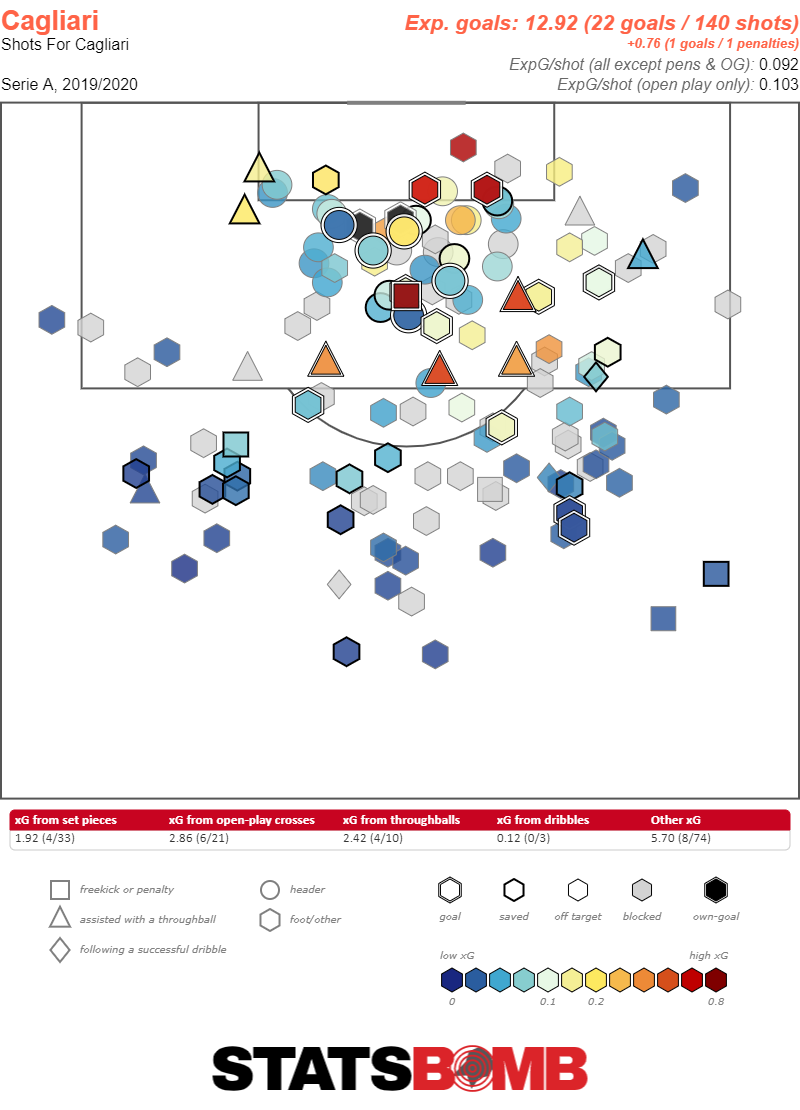
They generate just 11.50 shots per game, but so far, they have been excellent at converting set pieces and open-play crosses, while relying more on through-balls (from which last season they generated a meager total of 1.54 xG). With four goals Simeone is pretty much the only player who’s not currently overperforming his xG.
While it would be pretty much impossible to for Simone to fill the Pavoletti-shaped hole in the starting eleven, he brought a different kind of skill set that is arguably better suited to Maran’s 4-3-2-1. Pavoletti is a pure target-man, while the Argentine has more well-rounded qualities that allow him to open spaces for his teammates and to be a more dangerous threat when he patiently waits behind the defense. As because he turns the ball over a lot, his performances remain unconvincing, but his runs in each phase of play are certainly useful to his team.
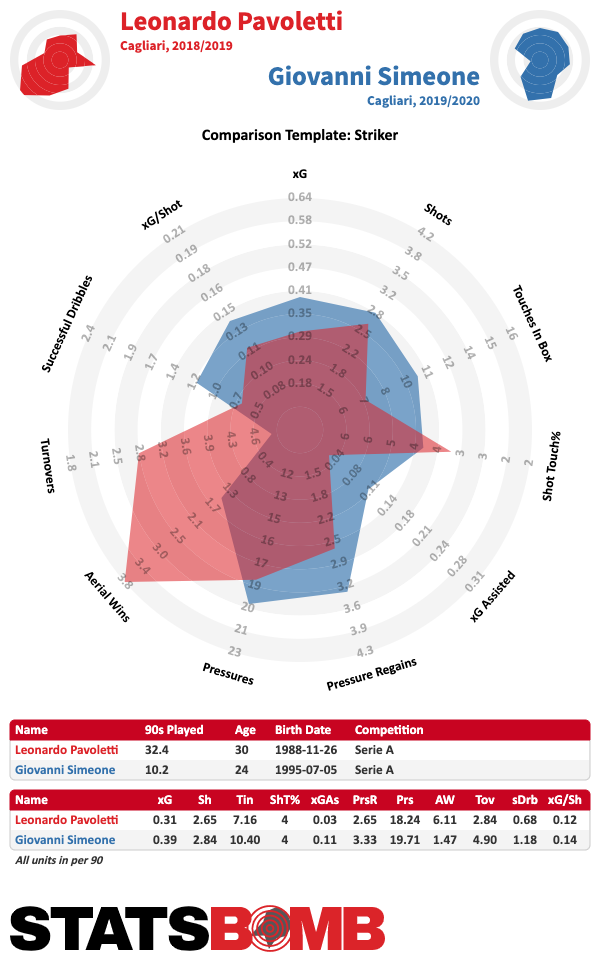
Yet Cagliari, who complete just 1.50 passes inside the box, are still reliant on crosses (36% of their box entries) so they would surely benefit of the comeback of their main striker. They will desperately need different offensive tools and alternative ways to create chances when the wind of conversion will stop blowing their way.
Their defensive phase set-up looks solid, but they are nothing more than a mid-table team according to their expected goal difference. To clinch European qualification and turn 2020 to an anniversary to remember, they must get better on offense; otherwise they must remain content with their first placing in the top half of the table in ten years.
